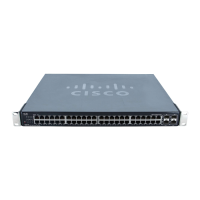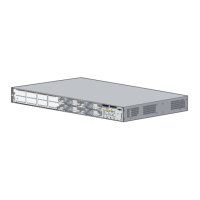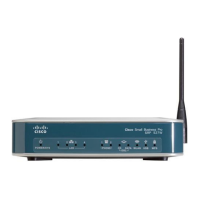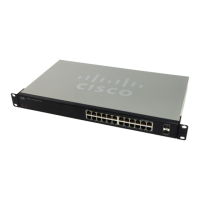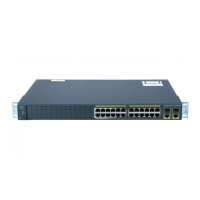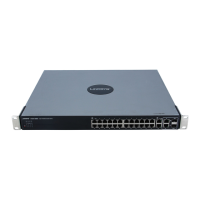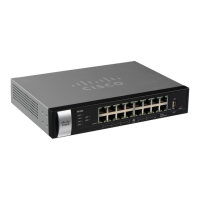Do you have a question about the Cisco SGE2000 and is the answer not in the manual?
Explanation of building and managing switch stacks to increase port density and provide link redundancy.
Procedures for replacing failed stack units, handling stack splits, merging stacks, and inserting too many units.
Information for enabling PoE, monitoring current power usage, and enabling PoE traps via the PoE Settings Page.
Configuration of user authentication, including defining user names and passwords for device access.
Setup of authentication profiles, mapping profiles, and configuring TACACS+ and RADIUS servers.
Configuration of access profiles, profile rules, and defining access control for management methods like Telnet, SSH, and HTTP.
Configuration of storm control to limit broadcast and multicast frames, and port security to control MAC address access.
Configuration of port-based authentication using the Extensible Authentication Protocol (EAP) via RADIUS servers.
Configuration of MAC-based and IP-based Access Control Lists (ACLs) and binding ACLs to interfaces for traffic filtering.
Configuration of global settings and Martian addresses to prevent Denial of Service (DoS) attacks on the device.
Configuration of Link Aggregation Groups (LAGs) to optimize port usage, increase bandwidth, and provide link redundancy.
Configuration of VLAN properties, including VLAN ID, name, type, and authentication settings.
Configuration of DNS server settings and host mapping for translating domain names into IP addresses.
Configuration of parameters for enabling STP on the device, including global, bridge, and designated root settings.
Configuration of Rapid Spanning Tree Protocol (RSTP) for faster STP convergence without creating forwarding loops.
Configuration of SNMP security settings, including defining Engine ID, Views, Users, Groups, and Communities.
Configuration of Quality of Service (QoS) general settings, including CoS, Queues, DSCP mapping, and bandwidth.
Configuration of advanced QoS features like flow classification, rule actions, DSCP mapping, class maps, and policers.
Procedure for upgrading device firmware, including specifying file type, TFTP server, and source/destination files.
Configuration and viewing of RMON statistics, including history, events, and alarms for network monitoring.
Explanation of building and managing switch stacks to increase port density and provide link redundancy.
Procedures for replacing failed stack units, handling stack splits, merging stacks, and inserting too many units.
Information for enabling PoE, monitoring current power usage, and enabling PoE traps via the PoE Settings Page.
Configuration of user authentication, including defining user names and passwords for device access.
Setup of authentication profiles, mapping profiles, and configuring TACACS+ and RADIUS servers.
Configuration of access profiles, profile rules, and defining access control for management methods like Telnet, SSH, and HTTP.
Configuration of storm control to limit broadcast and multicast frames, and port security to control MAC address access.
Configuration of port-based authentication using the Extensible Authentication Protocol (EAP) via RADIUS servers.
Configuration of MAC-based and IP-based Access Control Lists (ACLs) and binding ACLs to interfaces for traffic filtering.
Configuration of global settings and Martian addresses to prevent Denial of Service (DoS) attacks on the device.
Configuration of Link Aggregation Groups (LAGs) to optimize port usage, increase bandwidth, and provide link redundancy.
Configuration of VLAN properties, including VLAN ID, name, type, and authentication settings.
Configuration of DNS server settings and host mapping for translating domain names into IP addresses.
Configuration of parameters for enabling STP on the device, including global, bridge, and designated root settings.
Configuration of Rapid Spanning Tree Protocol (RSTP) for faster STP convergence without creating forwarding loops.
Configuration of SNMP security settings, including defining Engine ID, Views, Users, Groups, and Communities.
Configuration of Quality of Service (QoS) general settings, including CoS, Queues, DSCP mapping, and bandwidth.
Configuration of advanced QoS features like flow classification, rule actions, DSCP mapping, class maps, and policers.
Procedure for upgrading device firmware, including specifying file type, TFTP server, and source/destination files.
Configuration and viewing of RMON statistics, including history, events, and alarms for network monitoring.
| Jumbo Frame Support | 9KB |
|---|---|
| VLANs | Up to 256 |
| Management | Web-based, SNMP, CLI |
| Standards | IEEE 802.3, 802.3u, 802.3ab, 802.3z, 802.3x, 802.1D, 802.1Q, 802.1p, 802.1w |
| Dimensions | 440 x 44 x 257 mm |
| Power Supply | 100 to 240V AC, 50-60 Hz |
| Operating Temperature | 0°C to 40°C |
| Storage Temperature | -20 to 70°C (-4 to 158°F) |
| Humidity | 10% to 90% non-condensing |
| Weight | 3.2 kg |
